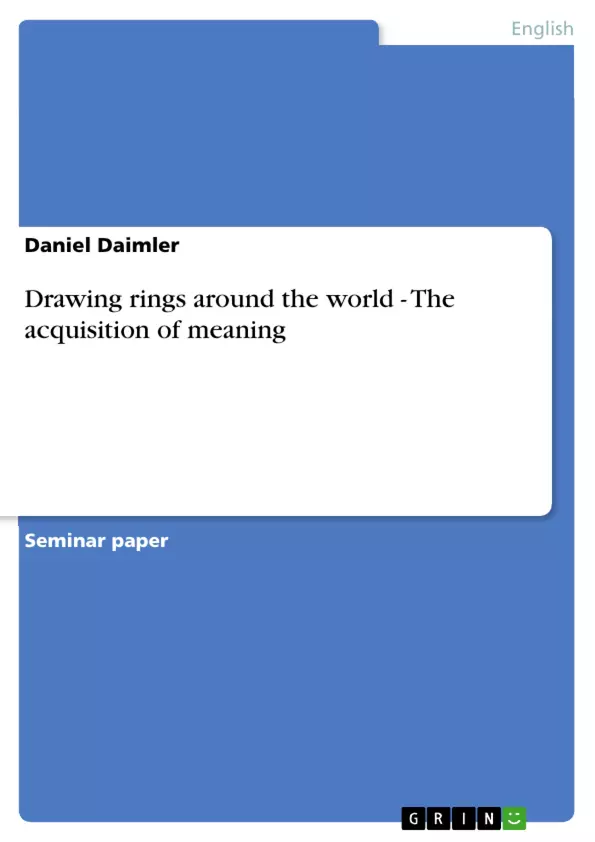This is the implication of the anthropic principle: a universe, that allows human existence can only be observed and conceptualised - linguistically structured, for our purpose - by human beings due to the constraints set by the internal structure of the universe. This is, any theory about the world and about the phenomena it consists of has to take into account that the available data possibly reflects only a sample of the topic to be theorised. Absolute objectivity is a myth. Theories should be regarded as points of view, in its very sense.
The fictional GOLEM XIV, artificial anthropologist at the MIT of the year 2029, encounters the problem from an opposite perspective: he knows well about man and the thematic role, man holds in universe. But he is not able to communicate about his knowledge without cutting down on his actual message because natural language does not provide the concepts required.
From this point of view, the study of semantic acquisition becomes a methodological one. When communicating linguistically about the world we live in and act on, how do we know that our words - those Saussurian signs with a concept on one side and an arbitrary form on another - actually cover the intended objects and ideas in their entirety? At least, the question is worth to be asked.
Bloom (2001) extends the question to at least two specifications. First, when discussing Williard Quine´s gavagai problem (describing the get-together of a linguist, a native speaker of some unexplored language, and a rabbit, at whose turn up the native utters the word gavagai), Bloom concludes that "there is an infinity of logically possible meanings for gavagai." (Bloom 2001:3). The utterance could refer to any component of this situation, the properties of the rabbit itself, such as its biological categorisation, its colour, texture, or acoustic appearance. Gavagai could even refer to the very spatio-temporal characteristics of the moment itself, to "time slices of rabbits", as Bloom puts it.
Table of Contents
- The Sky?s the Limit
- Introduction
- Approaches to Language Acquisition
- The Quest for Semantic Universals
- Rings Around the World
- Prototype Theory
- Semantic Feature Theory
- Functional Core Concept Theory
- Are You Talking to Me?
- A Brief History of Machine
- Discussion
Objectives and Key Themes
This paper delves into the intricate process of semantic acquisition, exploring how we learn to understand and use words. The focus is on both human and artificial linguistic systems, examining how meaning is constructed and communicated.
- Understanding the acquisition of word meaning in human language
- Exploring different theoretical approaches to semantic acquisition
- Investigating the role of universal semantic primitives in language
- Comparing semantic acquisition in human and artificial systems
- Analyzing the methodology of semantic acquisition research
Chapter Summaries
- The Sky?s the Limit: This chapter sets the stage for the discussion by exploring the inherent limitations of language and the challenges of capturing meaning accurately. It introduces the anthropic principle and the "gavagai" problem, emphasizing the subjective nature of language and the difficulty of achieving absolute objectivity. The chapter also discusses the nature-nurture debate in language acquisition, highlighting the role of innateness and the limitations of behaviorist approaches.
- Rings Around the World: This chapter presents three prominent theories of semantic acquisition: prototype theory, semantic feature theory, and functional core concept theory. Each theory offers a different perspective on how we learn word meanings, focusing on factors like prototypes, semantic features, and functional roles.
- Are You Talking to Me?: This chapter briefly introduces recent research on semantic acquisition in artificial linguistic systems. It explores experiments like The Talking Heads Experiment and examines approaches to supervised machine learning and case prototypicalities as semantic primitives.
Keywords
This paper focuses on key topics such as semantic acquisition, word meaning, prototype theory, semantic feature theory, functional core concept theory, language acquisition, artificial linguistic systems, and machine learning.
- Arbeit zitieren
- M.A. Daniel Daimler (Autor:in), 2003, Drawing rings around the world - The acquisition of meaning, München, GRIN Verlag, https://www.hausarbeiten.de/document/13168


